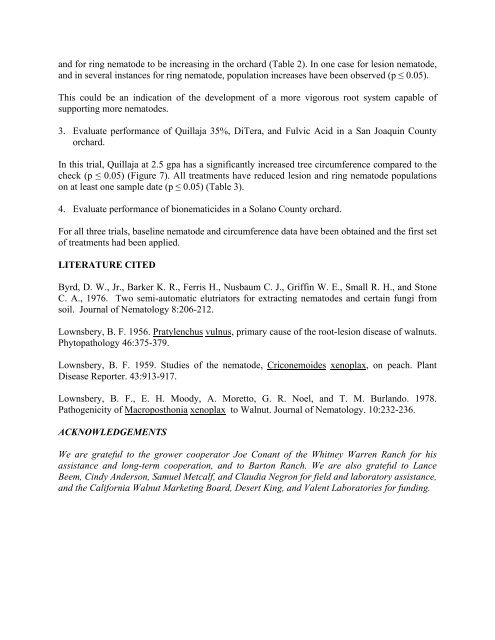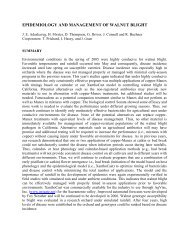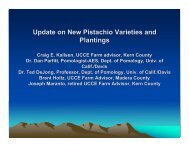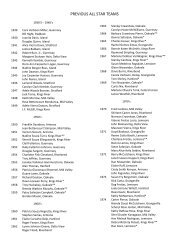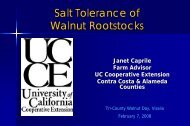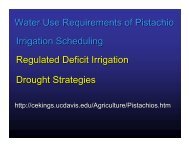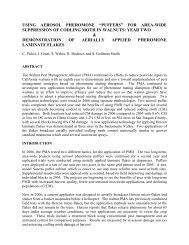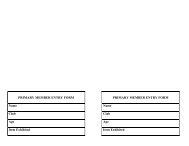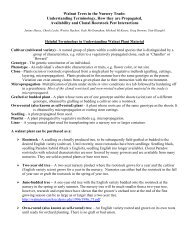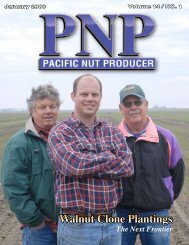nematode management in walnut orchards - Walnut Research Reports
nematode management in walnut orchards - Walnut Research Reports
nematode management in walnut orchards - Walnut Research Reports
Create successful ePaper yourself
Turn your PDF publications into a flip-book with our unique Google optimized e-Paper software.
and for r<strong>in</strong>g <strong>nematode</strong> to be <strong>in</strong>creas<strong>in</strong>g <strong>in</strong> the orchard (Table 2). In one case for lesion <strong>nematode</strong>,<br />
and <strong>in</strong> several <strong>in</strong>stances for r<strong>in</strong>g <strong>nematode</strong>, population <strong>in</strong>creases have been observed (p ≤ 0.05).<br />
This could be an <strong>in</strong>dication of the development of a more vigorous root system capable of<br />
support<strong>in</strong>g more <strong>nematode</strong>s.<br />
3. Evaluate performance of Quillaja 35%, DiTera, and Fulvic Acid <strong>in</strong> a San Joaqu<strong>in</strong> County<br />
orchard.<br />
In this trial, Quillaja at 2.5 gpa has a significantly <strong>in</strong>creased tree circumference compared to the<br />
check (p ≤ 0.05) (Figure 7). All treatments have reduced lesion and r<strong>in</strong>g <strong>nematode</strong> populations<br />
on at least one sample date (p ≤ 0.05) (Table 3).<br />
4. Evaluate performance of bionematicides <strong>in</strong> a Solano County orchard.<br />
For all three trials, basel<strong>in</strong>e <strong>nematode</strong> and circumference data have been obta<strong>in</strong>ed and the first set<br />
of treatments had been applied.<br />
LITERATURE CITED<br />
Byrd, D. W., Jr., Barker K. R., Ferris H., Nusbaum C. J., Griff<strong>in</strong> W. E., Small R. H., and Stone<br />
C. A., 1976. Two semi-automatic elutriators for extract<strong>in</strong>g <strong>nematode</strong>s and certa<strong>in</strong> fungi from<br />
soil. Journal of Nematology 8:206-212.<br />
Lownsbery, B. F. 1956. Pratylenchus vulnus, primary cause of the root-lesion disease of <strong>walnut</strong>s.<br />
Phytopathology 46:375-379.<br />
Lownsbery, B. F. 1959. Studies of the <strong>nematode</strong>, Criconemoides xenoplax, on peach. Plant<br />
Disease Reporter. 43:913-917.<br />
Lownsbery, B. F., E. H. Moody, A. Moretto, G. R. Noel, and T. M. Burlando. 1978.<br />
Pathogenicity of Macroposthonia xenoplax to <strong>Walnut</strong>. Journal of Nematology. 10:232-236.<br />
ACKNOWLEDGEMENTS<br />
We are grateful to the grower cooperator Joe Conant of the Whitney Warren Ranch for his<br />
assistance and long-term cooperation, and to Barton Ranch. We are also grateful to Lance<br />
Beem, C<strong>in</strong>dy Anderson, Samuel Metcalf, and Claudia Negron for field and laboratory assistance,<br />
and the California <strong>Walnut</strong> Market<strong>in</strong>g Board, Desert K<strong>in</strong>g, and Valent Laboratories for fund<strong>in</strong>g.


